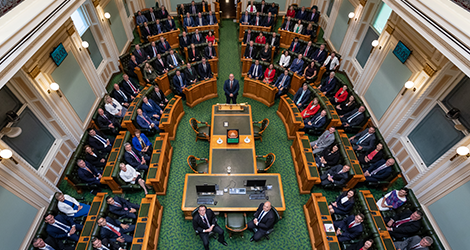United States President-elect Donald Trump .
Authors
- Adam Chapnick
Professor of Defence Studies, Royal Military College of Canada
- Asa McKercher
Hudson Chair in Canada-US Relations, St. Francis Xavier University
While there could be some exemptions for American imports of oil, gas and other natural resources, by the Canada-United States-Mexico Agreement (CUSMA).
In fact, when the deal comes up for a mandatory review in 2026, Trump has said: ” .”
Given that more than , Canadians have understandably viewed Trump’s declarations with alarm.
And against the likely torrent of American protectionism, Canada has few good options. Responding in kind, for example, will likely lead to a rise in inflation.
Kicking out Mexico?
One idea, recently floated by Ontario Premier Doug Ford, is to abandon CUSMA’s trilateral framework and seek a bilateral Canada-U.S. trade deal. As Ford put it: ” .”
The premier’s specific complaint is that the Mexican government has failed to prevent the in order subvert tariffs imposed by the American and Canadian governments against China.
If Mexico won’t act to prevent trans-shipments or impose its own tariffs on Chinese goods, Ford explained, “they shouldn’t have a seat at the table or enjoy access to the largest economy in the world.”
Ford’s comments , but Chrystia Freeland, Canada’s deputy prime minister and finance minister, was more sympathetic. Concerns about Mexican handling of Chinese goods ” are legitimate concerns for our American partners and neighbours to have. Those are concerns that I share ,” she said.
This is not the first time Canadians have expressed wariness about including Mexico in common North American arrangements.
Canada’s position on Mexico
In 1956, when U.S. President Dwight D. Eisenhower proposed a trilateral summit with Prime Minister Louis St. Laurent and Mexican President Adolfo Ruiz Cortines, Canadian diplomats expressed their opposition to anything that ” .”
For Ottawa, it was essential to preserve the notion of a between Canada and the U.S.
Even though the three leaders eventually met in Warm Springs, Ga., the “summit” ultimately consisted of separate U.S.-Canada and U.S.-Mexico bilateral meetings.
Four decades later, Canada pressed to be included in what became the North American Free Trade Agreeement – known as NAFTA – not because of any fellowship with Mexico, but to ensure that its newly won market access to the United States (thanks to between the U.S. and Canada) was not undercut by a bilateral Mexico-U.S. deal.
Common front?
As we document in our new book, , even if Canada’s suspicions of Mexico about trade matters aren’t out of the ordinary, they must be considered against the notion that in dealing with the U.S., there can be strength in numbers.
Throughout the early phase of the CUSMA negotiations during the first Trump presidency, Freeland herself was adamant that Canada not abandon Mexico in favour of a bilateral deal.
Rather, to present a common front against the Trump administration’s efforts divide its two North American trading partners.
When faced with an overwhelming aggressor, she argued, it’s best not to stand alone.
U.S. made side deal
This position was backed by other ministers as well as by Ottawa’s trade negotiators even as prominent Canadians – – called for ditching the Mexicans.
At first, the Canadian approach appeared to succeed. Freeland herself earned a among American officials, with Trump attacking her as a ” .”
Later, however, Canadian negotiators thought they saw an opening and .
Not only did Washington reject the offer, American officials approached Mexico City and . This time, it was Canada left unaware.
Warning signs
The threat of being cut out of a trade agreement was more imagined than real – – but Canada still had to move quickly to restore a trilateral solution.
CUSMA subsequently came into effect on July 1, 2020.
The CUSMA negotiations should offer Ford and the entire Canadian negotiating team a warning.
If Canada is prepared to leave Mexico behind, Canadian officials should be prepared for their Mexican counterparts to do the same. And while it seems right now that the U.S. has problems with Mexico than it does with Ottawa, under the mercurial Trump, the situation can can change in an instant.
It’s therefore probably not in Canada’s interest to throw Mexico under the bus.
![]()








